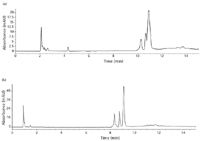Improving Intact IgG Separations with Aeris WIDEPORE Core-Shell HPLC/UHPLC Columns
The Application Notebook
Phenomenex Application Note
Michael McGinley, Deborah Jarrett and Jeff Layne, Phenomenex, Torrance, California, USA.
Introduction
A new widepore core-shell HPLC/UHPLC column (Aeris WIDEPORE) has been introduced that is specifically designed to improve protein separations. Rather than utilize a similar morphology of small molecule core-shell columns with larger pores, a completely different particle has been developed that takes into account the slower diffusion of proteins into porous particles. When one looks at different intact protein separations, the resolution of different glycoforms of therapeutic IgG antibodies probably stands out as one of the more difficult due to the large size and structure of IgG. In this article improved separation of IgG is shown using Aeris core-shell HPLC/UHPLC columns.
Materials and Methods
All chemicals, standards and antibodies were obtained from Sigma Chemical (St. Louis, Missouri, USA). Solvents were purchased from EMD (San Diego, California, USA). Fully porous 5 µ 300 Å C18 columns and core-shell Aeris 3.6 µm WIDEPORE XB-C18 columns (100 × 4.6 mm) were obtained from Phenomenex (Torrance, California, USA). Mouse immunoglobulin IgG samples were analysed on an Agilent 1200 HPLC system with autosampler, column oven, solvent degasser and UV detector set at 214 nm. Data was collected using Chemstation software (Agilent, Santa Clara, California, USA). Mobile phases used were 0.1% TFA in water (A) and 0.1% TFA in acetonitrile (B). A gradient from 10 to 40% (B) in 15 min was used at 1 mL/min. Column was maintained at 80 °C.

Figure 1
Results and Discussion
Aeris was designed to maximize resolution of proteins greater than 10 kilodaltons molecular weight regardless of the HPLC (or UHPLC) system used. A thin porous shell minimizes protein peak band spreading due to diffusion in and out of the porous layer and a larger particle size reduces column back pressure allowing for the use of longer columns for increased resolution. The result is a column with a performance on par or better than sub-2 µm widepore fully porous media at back pressures significantly lower than 3 µm fully porous columns. The performance advantage of Aeris WIDEPORE core-shell columns is demonstrated in Figure 1 where an Aeris column is compared to a 5 µm fully porous widepore column. IgG immunoglobulins are considered difficult proteins to separate by reversed-phase HPLC due their large size (150 KDa) and hydrophobicity. Typically, elevated column temperatures and isopropanol mobile phase are required to improve recovery and resolution. In this example mouse immunoglobulin IgG is compared on each column using an acetonitrile-only mobile phase at 80 °C (Aeris is stable to 90 °C). Note the significantly narrower peak width for the Aeris WIDEPORE core-shell column resulting in the resolution of the three main glycoforms of IgG versus the fully porous columns where only two components are seen. Of additional note is the greater recovery for the Aeris column; low hydrophobicity and good inertness results in greater recovery for hydrophobic proteins. The good resolution and recovery for this application demonstrates the utility of using core-shell Aeris WIDEPORE columns for immunoglobulin and large protein separations.
Phenomenex Inc.
411 Madrid Ave., Torrance, California, USA
tel: +1 310 212 055 fax: +1 310 212 7768
Website: www.phenomenex.com
















